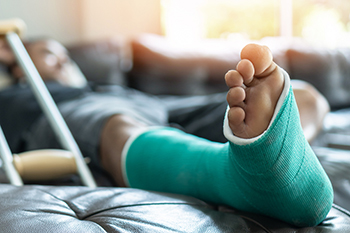
A sprained toe is a common foot condition. It can occur for a variety of reasons, that include an injury or accident causing the toe to bend beyond its normal range. When a toe is sprained, ligaments are overstretched or damaged. The toe may be swollen and bruised, and it can be painful to move, but walking is still possible. A Grade 1 sprain is known to be a mild sprain that consists of stretching of the ligaments and perhaps some microscopic tears. A Grade 2 sprain is a partial tear with more noticeable swelling and tenderness. A Grade 3 sprain happens when the ligament is completely torn, and the pain level is significant. Since it is difficult to distinguish between a sprained toe and a fractured toe, it is suggested that if you have sustained a toe injury, a podiatrist be consulted who can properly diagnose what has happened and provide appropriate treatment.
Toe pain can disrupt your daily activities. If you have any concerns, contact one of our podiatrists of Foot Health Center of Merrimack Valley. Our doctors can provide the care you need to keep you pain-free and on your feet.
What Causes Toe Pain?
Most severe toe pain is caused due to a sports injury, trauma from dropping something heavy on the toe, or bumping into something rigid. Other problems can develop over time for various reasons.
Toe pain can be caused by one or more ailments. The most common include:
- Trauma
- Sports injury
- Wearing shoes that are too tight
- Arthritis
- Gout
- Corns and calluses
- Hammertoe
- Bunions
- Blisters
- Ingrown toenails
- Sprains
- Fractures (broken bones)
- Dislocations
When to See a Podiatrist
- Severe pain
- Persistent pain that lasts more than a week
- Signs of infection
- Continued swelling
- Pain that prevents walking
Diagnosis
In many cases the cause of toe pain is obvious, but in others, a podiatrist may want to use more advanced methods to determine the problem. These can range from simple visual inspections and sensation tests to X-rays and MRI scans. Prior medical history, family medical history, and any recent physical traumatic events will all be taken into consideration for a proper diagnosis.
Treatment
Treatments for toe pain and injuries vary and may include shoe inserts, padding, taping, medicines, injections, and in some cases, surgery. If you believe that you have broken a toe, please see a podiatrist as soon as possible.
If you have any questions please feel free to contact one of our offices located in North Andover, and Tewksbury, MA . We offer the newest diagnostic tools and technology to treat your foot and ankle needs.











